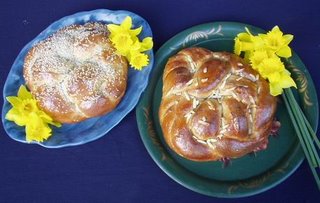
Greek Easter Breads: Sesame and Almond Tsoureki
FLASH: There are some absolutely beautiful origami-paper-covered Easter eggs which look quite easy to make on p. 85 of the April 2004 issue of Martha Stewart Living magazine. The instructions are available online here. **Vegans can cover ceramic or wooden "eggs", available at crafts stores, instead of blown-out real eggs.** UPDATE: Dye-able ceramic eggs, called Eggnots, are available here and here is the distributor in Canada. Paintable wooden eggs a readily available on Etsy.com.
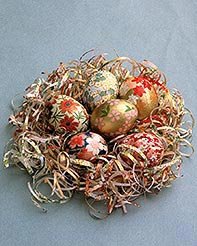
This is a picture from Martha Stewart Living-- I didn't make these, BTW.
I have a thing about Easter breads. Easter doesn't seem like Easter without one. The yeast-risen breads are symbols of rebirth and the ring shapes of everlasting life. Eggs are also highly symbolic of rebirth. As vegans, we don't have to use real eggs-- we can use egg shapes in a symbolic way.
I used to make a special Italian Easter bread ring every year, because my father's Italian aunt, Tia Maria, made it every Easter in an outdoor oven in Lima, Peru. Of course, it contained eggs and butter, and was baked with raw, colored eggs nestled in the puffy dough (the eggs baked along with the bread).
I developed my own vegan version of this bread, but my oldest daughter, Bethany, still makes the one she grew up with, pictured here:
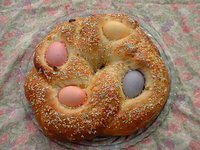
This is my vegan version, without eggs:
Printable Recipe:
BRYANNA'S PANE DI PASQUA (ITALIAN EASTER BREAD RING), GENOVESE-STYLE
(adapted from my book "Nonna's Italian Kitchen
© Bryanna Clark Grogan 2006
Because my father's maternal family came from the Genoa region of Italy, this Easter bread is flavored with orange flower water
This bread is traditionally made with colored raw eggs baked right in the twists of sweet dough. To stay vegan, but keep the ancient Spring Equinox/Easter egg-as-symbol-of-new-life-and-renewal theme, you can mound candy eggs in colored paper "straw" in the center of the ring (dairy-free, naturally-sweetened, organic chocolate eggs are available in many health food stores at Easter, or from amazon.com in vegan milk chocolate or vegan dark chocolate), or use polished colored decorative stone eggs
1/2 c. warm water
2 tsp. dry active baking yeast (or 1 1/2 tsp. instant yeast)
1/4 tsp. real Spanish saffron
1/2 c. nondairy milk
1/4 c. light organic unbleached sugar
3 T. vegan butter (try my palm-oil-free version)
grated zest of one orange (organic, if possible)
4 tsp. orange flower water (available in many Middle Eastern markets or gourmet stores)
2 tsp. vanilla
3/4 tsp. salt
1/2 tsp. fennel seeds, crushed
1/4 tsp. ground coriander
2 3/4 c. unbleached white flour
1/4 c. wheat germ
1/3 c. EACH golden raisins, dried currants, and chopped dried apricot
1/3 c. chopped lightly toasted pine nuts
Add the yeast and saffron to the warm water in a cup and let sit 5 or 10 minutes, until bubbly.
In a small saucepan or a microwave, heat the milk until it is just hot, with bubbles around the edges. Add the sugar and margarine and stir to dissolve. When the milk has cooled down a bit, add it to the yeast and water. Pour this into a large mixing bowl or the bowl of a heavy-duty mixer with a bread hook.
Add the orange zest(white only), orange flower water, vanilla, salt, crushed fennel, and ground coriander to the bowl. Stir in the wheat germ and 1 cup of the flour. Beat well for a minute or two, then gradually add the remaining flour.
Knead with a dough hook or by hand on a floured surface (adding as little flour as you can get away with-- oil your hands and the surface, if necessary) for 5-10 minutes.
FOOD PROCESSOR DOUGH:
You can make this dough in a food processor, following the directions given with your machine. DO NOT add the dried fruit and nuts to the machine-- knead them in by hand after the first rising as instructed in the recipe. Process the dough ("knead") for 30-60 seconds.
TO MAKE THE DOUGH IN A BREAD MACHINE:
Place the ingredients in the bread container in the order instructed for your machine. DO NOT add the dried fruit and nuts at the beginning. If your machine has a sweet bread cycle, it will beep when it's time to add these ingredients. Otherwise, you'll have to pay attention and add them toward the very end of the kneading cycle, so that they don't get pulverized. Let the bread go through the rising cycle.
WHICHEVER WAY YOU KNEADED IT:
Place the dough in a lightly-oiled bowl and turn it over to coat the top. Place the bowl in a large plastic bag or cover with a clean, damp tea towel and let rise in a warm place until doubled in size, 1 to 1 and 1/2 hours.
Turn the risen dough out on a lightly-floured surface and pat it out into a flat rectangle. Sprinkle the surface with the dried fruits and pine nuts. Roll up the dough jelly-roll style, then fold up the ends. Knead the dough gently by folding and rolling until the fruit, etc., are well-distributed throughout the dough.
Cut the risen dough in half. Roll each half on a lightly-floured board into a 24"-long "rope". Twist the two ropes of dough together loosely (starting in the middle) and form them into a ring on a lightly-greased baking sheet, tucking the ends together neatly and evenly. (See photos below.)
Meanwhile, preheat the oven to 350 degrees F. Bake the loaves for 30 minutes in the center or upper half of the oven, or just until they are a deep golden brown and sounds hollow when tapped on the bottom. Place on a rack to cool.
Spread either a powdered sugar glaze (organic powdered sugar is available), or the Protein-Sugar Glaze or White Maple Glaze (see recipes below) this on the bread while it's still warm and sprinkle the top with colored candy sprinkles, if you like.
BRYANNA’S WHITE MAPLE GLAZE Makes 1/2 c.
This can be used on sweet yeasted breads, tea breads, cupcakes, etc..
1/2 c. good-tasting powdered nondairy milk beverage (such as Better Than Milk soy or rice beverage mix or potato milk powder-- do not use bulk soymilk powder)
4 T. Grade A light maple syrup
1/4 tsp. vanilla or other flavor extract
Mix the ingredients together thoroughly in a bowl. For a thin glaze, spread it on the hot bread or cake. For a firmer glaze, spread it on the cooled bread or cake.
BRYANNA’S PROTEIN-SUGAR GLAZE Makes about 1/2 c.
For a sweeter glaze that gets a bit crusty, try this easy one. If you use unbleached sugar, it's more beige than white. It's good on baked doughnuts or muffins baked in miniature bundt pans .
1/2 c. light organic unbleached sugar
2 T. nondairy milk
2 T. rice protein powder or isolated soy protein powder
1/4 tsp. vanilla or other flavor extract
Melt the sugar and milk together in a small saucepan over medium heat, stirring, or MICROWAVE in a microwave-safe small bowl for 1 minute. Beat in the protein powder and vanilla with a hand blender or electric mixer. Spread on hot cake, etc..
ANOTHER OF MY FAVORITE EASTER BREADS IS GREEK TSOUREKI:
This lovely braided Easter bread is usually made with dyed red eggs baked into the indentations in the braid, but, for a vegan bread, you can surround the bread (after baking and cooling) with red egg-shaped candles or candies. (UPDATE: Now you can use red-dyed ceramic eggs baked into the bread. They are called Eggnots and there are links to info in the 1st paragraph of this post.)The eggs are an ancient religious symbol of fertility and rebirth, and red symbolizes Christ’s blood. Unfortunately, I didn’t have either at my disposal when I made my breads and took photos of them.
You can use the same dough as above and form it in the same way, but omit the orange zest, vanilla, fennel, coriander, dried fruit and pine nuts (you can use chopped almonds instead, if you wish), and, instead, use 1 tsp. of the Greek spice mahlepi described in the next paragraph, or use 3/4 tsp. ground anise seed. Instead of using a powdered sugar glaze (organic powdered sugar is available) or one of the glazes above, brush the cooled breads with this Sweet Glaze: Heat equal parts nondairy milk and maple syrup over medium heat. Do not boil or it may curdle. Brush over the breads to make a shiny glaze and sprinkle the loaves with lightly-toasted slivered almonds or sesame seeds.
Instead of the spices and dried fruits in the Italian bread, the Greek version is flavored with the Greek spice mahlepi,originally from Persia-- the hard small seed of a flowering tree like a cherry. It has a lovely spicy smell. You can find it in on amazon or in Greek and Middle Eastern grocery stores, but if you are unable to locate it, you can make a liquid substitute by simmering together over low heat for 20 minutes: 3 whole cloves, 1/2 a stick of cinnamon, 1 bay leaf and 3/4 c. water. Strain and use 2 T. for every 1 T. of mahlepi called for. (From" Cooking and Baking the Greek Way" by Anne Theoharous, Holt, Rinehart and Winston, New York, 1977.)
FORMING TSOUREKI OR PANE DI PASQUA:
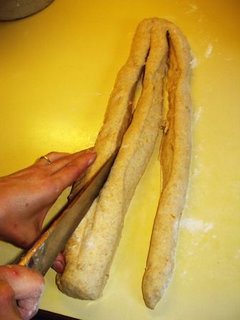

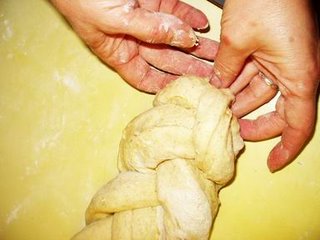


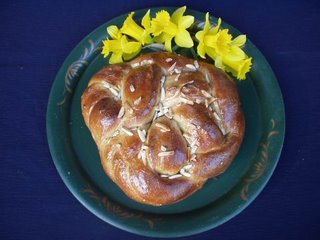

Last year I tried to bake real eggs in the dough like Bethany did, but my dough didn't bake up as perfectly symmetricla as hers did - beautiful! I am planning on trying the cinnamon roll bunny like was given as an idea last year.
ReplyDeleteI made your Easter bread and braided like in the picture. It was WONDERFUL! I LOVE it. It taste good, it looks good, and it's VEGAN! I don't miss the egg and butter at all.
ReplyDeleteThanks for such a great recipe!
SIV
Beautiful!!!
ReplyDeleteI love braided Easter breads with eggs in them. Before I went vegan, I used to make a Portuguese Easter bread with eggs braided in.
ReplyDelete"the eggs are an ancient religious symbol of fertility and rebirth, and red symbolizes Christ’s blood"
I am Greek Orthodox and we say that the red eggs (which we give out at the end of the Pascha Vigil on Holy Saturday) are from the missionary work of Saint Mary Magdalene.
From Orthodoxwiki,org:
"According to tradition, during a dinner with the emperor Tiberius Caesar, Mary Magdalene was speaking about Christ's Resurrection. Caesar scoffed at her, saying that a man could rise from the dead no more than the egg in her hand could turn red. Immediately, the egg turned red. Because of this, icons of Mary Magdalene sometimes depict her holding a red egg. Also, this is believed to be an explanation for dyeing eggs red at Pascha."
Sparrtow Rose, I've never heard that interpretation before. Thanks for telling us about it! Here is a passage from an Orthodox website, which shows a link between both interpretations!
ReplyDelete"With Christianity, the old belief receives new contents, and the egg receives a religious significance amongst the Christians. There exisits a tradition which makes Mary Magdalene to be the originator of the custom of using red eggs on Easter day. After the Ascension of our Saviour, Mary Magdalene went to Rome to preach the Gospel and, appearing before the Emporer Tiberius, she offered him a red egg, saying: CHRIST IS RISEN.” Thus was begun her preaching. Learning about this offering of Mary Magdalene, the early Christians imitated her, presenting each other with eggs. Hence, eggs began to be used by Christians in the earliest centuries as a symbol of the Resurrection of Christ and of the regeneration of Christians for a new and a better life along [with] it. The custom of presenting each other with red eggs was familiar to the Christians of the earliest Universal Church.
The red color, which generally is used for Easter eggs, serves to remind us of the precious blood of God the Redeemer, which was shed on the cross for the salvation of all men."
http://southern-orthodoxy.blogspot.com/2006/04/red-eggs-at-pascha-easter.html
Thank You! I used this recipe to great success :)My mother makes Easter Bread every year and I didn't think a vegan version was possible, now I know-it is.
ReplyDeleteDo you have a vegan recipe for Paska Easter Bread? It's a sweet bread my grandma made with orgage juice and orange zest.
ReplyDeleteDo you have a vegan recipe for Paska Easter Bread? It's a sweet bread my grandma made with orgage juice and orange zest.
ReplyDeleteRae Ann-- so sorry that I didn't get to this in time for Easter! I know I worked on this at one time, but have to locate my files and maybe re-test it. So, I hope I can come up with something for next Easter!
ReplyDelete